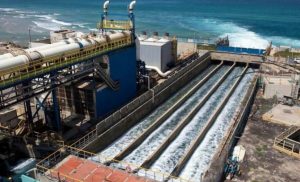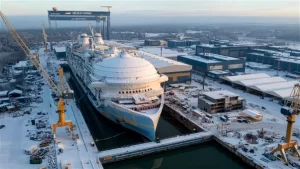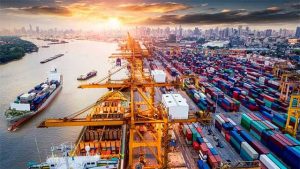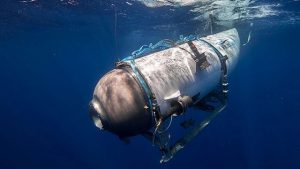- août 14, 2023
- zidox
- (0)
- International Economy
Introduction
The maritime world is abuzz with anticipation as the grand debut of the « Icon of the Seas » approaches. Commissioned by Royal Caribbean, this colossal cruise ship is set to redefine the limits of maritime engineering and luxury travel. However, as its grandeur captures attention, concerns over its ecological footprint and the implications of its size have ignited a debate within both the industry and environmental circles.
A Floating Wonderland
Set to embark on its maiden voyage in January 2024, the « Icon of the Seas » boasts an array of extravagant features that rival a small town. With a staggering seven swimming pools, fifteen bars and restaurants, a water park, and an unexpected ice rink, this floating city promises an unparalleled experience for its passengers. Constructed at the Turku shipyard in Finland, it is heralded as the largest cruise ship in the world, towering above all others with its impressive gross tonnage of 250,800 tonnes.
A Marvel of Engineering
The creation of this floating paradise began in 2021, sparking both admiration for its sophisticated engineering and concern about its environmental impact. The ship’s most distinctive feature is its massive glass dome that graces its bow, a testament to modern maritime design. Its capacity to accommodate nearly 10,000 people, including 7,600 passengers, sets new records, dwarfing even the Titanic in scale.
Economic Advantages and Environmental Dilemmas
The growing trend of constructing ever-larger cruise ships has its economic rationale. According to Alexis Papathanassis, a professor of cruise management, these colossal vessels achieve economies of scale, ultimately reducing the cost per passenger. Proponents of this gigantism also argue that large ships are more energy-efficient than multiple smaller vessels combined. However, critics argue that the proliferation of such massive ships raises concerns about the environmental consequences, given their potential to exacerbate climate change and the challenges they pose to overburdened ports and infrastructures.
The Ecological Debate
While the cruise industry has gradually rebounded from the impacts of the Covid-19 pandemic, questions about sustainability and environmental responsibility remain paramount. The « Icon of the Seas » is fueled by liquefied natural gas (LNG), touted as a cleaner alternative to traditional marine fuels. Nonetheless, experts point out that LNG can release methane, a potent greenhouse gas with serious climate implications. This conundrum highlights a paradox: while LNG reduces carbon emissions, it might inadvertently encourage the expansion of the gas industry, further perpetuating environmental concerns.
A Path Forward
As the world anticipates the inaugural voyage of the « Icon of the Seas, » the cruise industry stands at a crossroads. While larger vessels bring undeniable economic advantages and innovative design marvels, they also raise alarms about ecological sustainability. Striking a balance between opulence and environmental responsibility is paramount for the future of cruise travel. As the industry continues to evolve, it is hoped that innovative solutions will emerge to address the ecological concerns while still offering passengers unparalleled experiences on the high seas.
JOB OFFERS

2025 Seauto Crab Pro Pool Cleaning Robot – Smart, Efficient, and Wall-Climbing!

2024’s Best Cooling Maternity Pillow – Full Body Support for Pregnancy Comfort

Premium Pregnancy Body Pillow – Optimal Support for Better Sleep

🔥 MXQ-Pro Smart TV BOX – Turn Your TV into a 4K Media Hub for Under €14!

Elegant 10K White Gold Diamond Ring Set – Perfect for Weddings or Gifts

👉 🕒 Elegance and Reliability: Gold-Plated Luxury Women’s Watch

Real Estate Prices in 2025: What Trends to Expect?

The Real Estate Market in 2025: Trends, Challenges, and Opportunities

BYD Seal U DM-i (2025) – The new plug-in hybrid SUV that aims to shake things up

BYD: The Chinese giant changing the rules of the global auto market

🔥 2026 Honda S2000 – The Legendary Comeback Announced! 🔥

11 Used European Sports Cars You Can’t Miss

🚗 French Car Models to Watch in 2025

LG Showcases AI Innovations at CES Las Vegas 2025

Audi S8 2025 vs. Volkswagen Beetle 2025: Luxury Meets Iconic Design

GIVE THIS NEW TESLA A NAME!!

The Minister of Industry calls for lowering the prices of Opel cars to meet the expectations of Algerian consumers

who is the founder of YouTube, what year, how it went global and how it became affiliated with Google

who is the founder of Google, in what year and how it became global

list of the 10 most visited sites in the world!

The Bibliothèque of Diligence and Honesty

« The Redemption of Broken Hearts »

How to Win Hearts and Make People Love You

how to learn a new programming language quickly
Comment Gagner de l’Argent sur Internet en 2023 : Le Top 25

Preserving the Environment and Meeting Needs: Environmental Research Projects Support Desalination Efforts on the Algerian Coast
« Icon of the Seas: Exploring the World’s Largest Cruise Ship Amidst Ecological Concerns »

« Sonatrach: Selection of 266 Candidates Following the Recruitment Competition in Adrar and Timimoun »

Paradise Beaches: The Top 10 Destinations according to TripAdvisor in 2023

Le plus grand paquebot du monde, « Icon of the Seas », fera cinq fois la taille du Titanic : portrait d’une aberration

Augmentation inattendue des primes d’assurance habitation en France pour les Algériens résidant dans le pays

India will become the world’s second largest economy by 2075, surpassing the United States

Heat wave in Algeria: Weather alert with temperatures reaching 49 ° C

Meet Thermonator, a terrifying flame-throwing robot dog

Where will artificial intelligence lead us?

Tragedy Strikes as Submarine Titan Lost at Sea Near Titanic Wreckage

Actor’s Terrifying Account of « Titan » Submarine Trip to Titanic Wreck Reveals Serious Malfunctions

What is the economy? And how does it work to achieve the welfare of people?

Dazzling: The discovery of an « incredible » sword thousands of years old that still shines

Elon Musk threatens to implement talent subscriptions to Twitter Blue

Schengen visa: 10 easiest countries in 2023

With a political message: The Syrian star, Shukran Murtaji, thanks the Algerian government and people

Liste des sites de petites annonces en Algérie

Découvrez les meilleurs sites de petites annonces en Algérie

Turkish citizens to receive free natural gas for a year as country reaches historic milestone

After a SpaceX rocket explodes, Elon Musk loses $13 billion in one day

« Twitter Controversy: Celebrities Lose Authentication Marks Due to Musk’s New Policy »

Elon Musk Replaces Twitter’s Blue Bird with Dogecoin

« President of the German Banking Association: The risk of a comprehensive banking crisis in Europe is very low »

Germany.. Investor sentiment for the Volkswagen factory fell unexpectedly in April


Leave a Reply